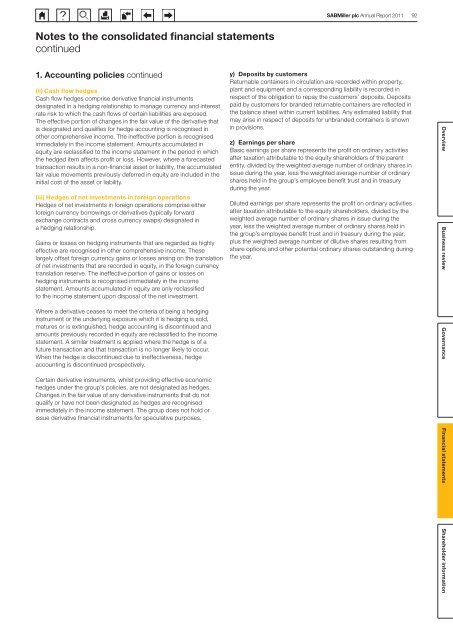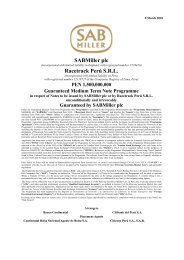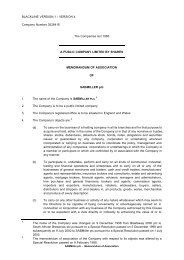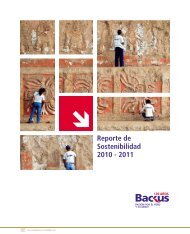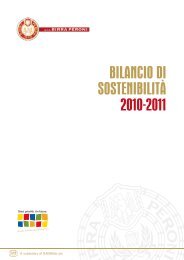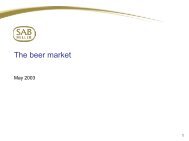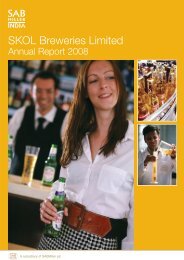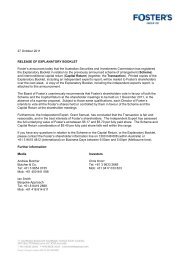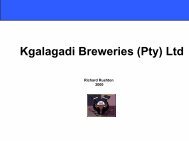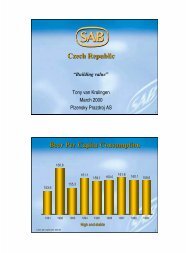Download the interactive SABMiller plc 2011 Annual report PDF
Download the interactive SABMiller plc 2011 Annual report PDF
Download the interactive SABMiller plc 2011 Annual report PDF
Create successful ePaper yourself
Turn your PDF publications into a flip-book with our unique Google optimized e-Paper software.
<strong>SABMiller</strong> <strong>plc</strong> <strong>Annual</strong> Report <strong>2011</strong> 92<br />
Notes to <strong>the</strong> consolidated financial statements<br />
continued<br />
1. Accounting policies continued<br />
(ii) Cash flow hedges<br />
Cash flow hedges comprise derivative financial instruments<br />
designated in a hedging relationship to manage currency and interest<br />
rate risk to which <strong>the</strong> cash flows of certain liabilities are exposed.<br />
The effective portion of changes in <strong>the</strong> fair value of <strong>the</strong> derivative that<br />
is designated and qualifies for hedge accounting is recognised in<br />
o<strong>the</strong>r comprehensive income. The ineffective portion is recognised<br />
immediately in <strong>the</strong> income statement. Amounts accumulated in<br />
equity are reclassified to <strong>the</strong> income statement in <strong>the</strong> period in which<br />
<strong>the</strong> hedged item affects profit or loss. However, where a forecasted<br />
transaction results in a non-financial asset or liability, <strong>the</strong> accumulated<br />
fair value movements previously deferred in equity are included in <strong>the</strong><br />
initial cost of <strong>the</strong> asset or liability.<br />
(iii) Hedges of net investments in foreign operations<br />
Hedges of net investments in foreign operations comprise ei<strong>the</strong>r<br />
foreign currency borrowings or derivatives (typically forward<br />
exchange contracts and cross currency swaps) designated in<br />
a hedging relationship.<br />
Gains or losses on hedging instruments that are regarded as highly<br />
effective are recognised in o<strong>the</strong>r comprehensive income. These<br />
largely offset foreign currency gains or losses arising on <strong>the</strong> translation<br />
of net investments that are recorded in equity, in <strong>the</strong> foreign currency<br />
translation reserve. The ineffective portion of gains or losses on<br />
hedging instruments is recognised immediately in <strong>the</strong> income<br />
statement. Amounts accumulated in equity are only reclassified<br />
to <strong>the</strong> income statement upon disposal of <strong>the</strong> net investment.<br />
Where a derivative ceases to meet <strong>the</strong> criteria of being a hedging<br />
instrument or <strong>the</strong> underlying exposure which it is hedging is sold,<br />
matures or is extinguished, hedge accounting is discontinued and<br />
amounts previously recorded in equity are reclassified to <strong>the</strong> income<br />
statement. A similar treatment is applied where <strong>the</strong> hedge is of a<br />
future transaction and that transaction is no longer likely to occur.<br />
When <strong>the</strong> hedge is discontinued due to ineffectiveness, hedge<br />
accounting is discontinued prospectively.<br />
Certain derivative instruments, whilst providing effective economic<br />
hedges under <strong>the</strong> group’s policies, are not designated as hedges.<br />
Changes in <strong>the</strong> fair value of any derivative instruments that do not<br />
qualify or have not been designated as hedges are recognised<br />
immediately in <strong>the</strong> income statement. The group does not hold or<br />
issue derivative financial instruments for speculative purposes.<br />
y) Deposits by customers<br />
Returnable containers in circulation are recorded within property,<br />
plant and equipment and a corresponding liability is recorded in<br />
respect of <strong>the</strong> obligation to repay <strong>the</strong> customers’ deposits. Deposits<br />
paid by customers for branded returnable containers are reflected in<br />
<strong>the</strong> balance sheet within current liabilities. Any estimated liability that<br />
may arise in respect of deposits for unbranded containers is shown<br />
in provisions.<br />
z) Earnings per share<br />
Basic earnings per share represents <strong>the</strong> profit on ordinary activities<br />
after taxation attributable to <strong>the</strong> equity shareholders of <strong>the</strong> parent<br />
entity, divided by <strong>the</strong> weighted average number of ordinary shares in<br />
issue during <strong>the</strong> year, less <strong>the</strong> weighted average number of ordinary<br />
shares held in <strong>the</strong> group’s employee benefit trust and in treasury<br />
during <strong>the</strong> year.<br />
Diluted earnings per share represents <strong>the</strong> profit on ordinary activities<br />
after taxation attributable to <strong>the</strong> equity shareholders, divided by <strong>the</strong><br />
weighted average number of ordinary shares in issue during <strong>the</strong><br />
year, less <strong>the</strong> weighted average number of ordinary shares held in<br />
<strong>the</strong> group’s employee benefit trust and in treasury during <strong>the</strong> year,<br />
plus <strong>the</strong> weighted average number of dilutive shares resulting from<br />
share options and o<strong>the</strong>r potential ordinary shares outstanding during<br />
<strong>the</strong> year.<br />
Overview Business review Governance Financial statements Shareholder information


